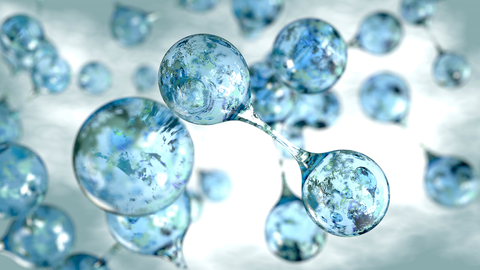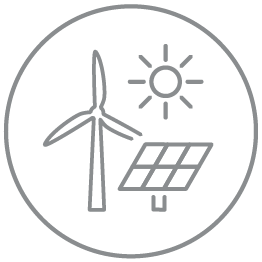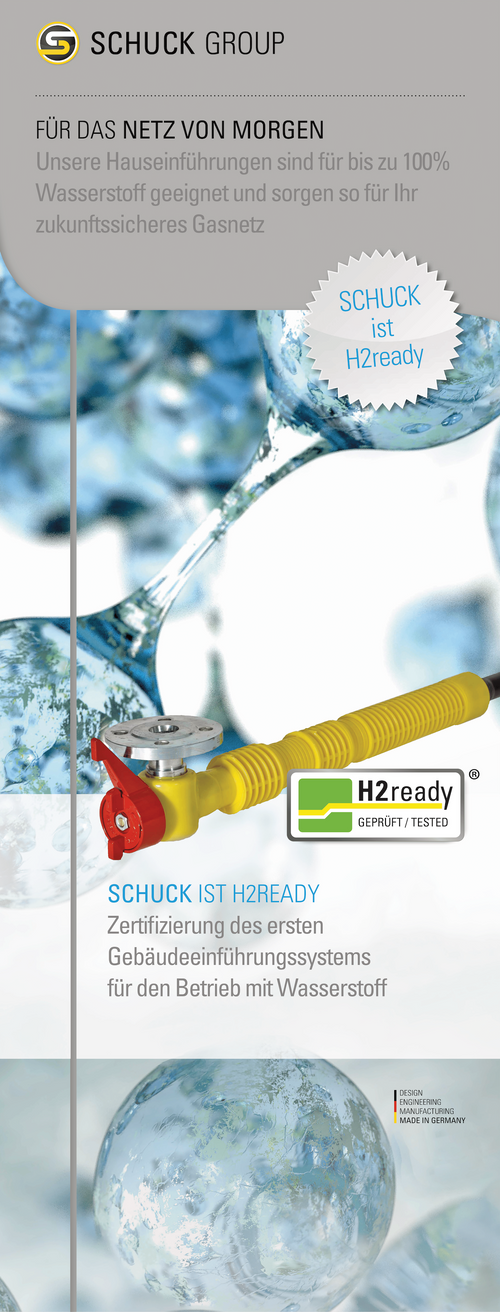
H2READY - THE HYDROGEN INITIATIVE
With the announcement of the hydrogen strategy in June 2020, the German Federal Government ushered in a new era in the use of alternative energy sources. The central role here is played using so-called green hydrogen as a game changer in the energy industry.
For us as an established system manufacturer for everything to do with energy supply and as an innovative pioneer in the industry, it is a matter of course to be a part of this process.
The Schuck Group has already got in the mood for this mega trend and started developing its products further and new at an early stage.
We spoke to the responsible product manager Robert Barthle about this.

What is hydrogen?
Hydrogen (H2) is a flammable gas that can be obtained from water in a CO2-neutral manner by electrolysis with electricity. So, it is not a primary energy source like coal, oil or gas, but has to be generated artificially.
If green electricity is used here, the result is climate-neutral green hydrogen - an important future energy carrier.
When hydrogen is burned or used in a fuel cell, no CO2 is produced, but water.
Why is hydrogen especially interesting as a future energy carrier?
Since hydrogen is a gas, it can be transported and stored in a similar way to natural gas. The infrastructure is available and can be used with minor adjustments. In contrast to the relatively environmentally friendly natural gas, however, hydrogen can be completely CO2 neutral.
Hydrogen can provide large amounts of energy across sectors for transport, heating, industry, power generation and thus enable sector coupling.
These properties make hydrogen an indispensable energy carrier for a successful energy transition.

Hydrogen storage?
Energy must be stored for a secure supply. If the volatile generation of renewable electricity cannot cover the current demand, additional energy must be available from a storage facility.
State-of-the-art battery storage systems could bridge a maximum of a few minutes to hours. However, this is by no means sufficient for a secure energy supply.
The " dark doldrums " are particularly critical here. The dark doldrums occur every few years and last for several days to a few weeks. During this time - usually in winter, when there is little sunshine, hardly any wind blows and the energy requirement is particularly high - conventional electricity storage systems (battery, pump storage ...) quickly reach their limits.
In underground storage facilities for hydrogen, on the other hand, gigantic seasonal storage capacities are available.
In critical phases, the hydrogen, which has been regeneratively produced and stored over the year, can be converted back into electricity, or used directly, thus covering the energy requirement for many weeks and maintaining security of supply.

How can hydrogen be used to transport energy?
Since Germany already has a largely area-wide network for natural gas, in which there are also large transport lines from north to south and from east to west as well as to many households, generated hydrogen (e.g. offshore in the North Sea) can already be used in the energy-hungry areas in the South and west of Germany.
New power lines, high costs for them, citizens' initiatives on the other hand, environmental damage and long implementation times can be avoided if the existing natural gas infrastructure is used for the transport of renewable energies in the form of hydrogen. The import of energy from wind or sun-rich regions of the world must also be ensured with hydrogen.

How far is Schuck?
To achieve the Paris climate goals (COP21), action must be taken quickly. Components that are installed in the network today have an expected useful life of at least 50 years. The entry into the hydrogen economy as a replacement for fossil fuels must take place much earlier, in the twenties of this century, on a significant scale, in order not to miss COP21. Components that are connected to the grid today must therefore be designed to transport not only pure natural gas, but also mixtures with hydrogen and even pure hydrogen in the future.
Although hardly any hydrogen is currently being fed into the natural gas network, Schuck has already approved the first products for use with hydrogen. This includes the Schuck gas house entry, some versions of the Schuck ball valve’s and material transition connectors. The scope of tested and approved products in the Schuck range is constantly being expanded and perceived as an important future task.

What is H2ready?
H2ready is a test mark for media-carrying products that ensures suitability for hydrogen up to 100%. The "H2ready" test mark is awarded by the DBI after the products have been subjected to intensive practical and theoretical tests. The scope of the tests was defined jointly by DBI, large utility companies and Schuck. As an H2ready pioneer, Schuck is very proud to be providing the Schuck HSP gas house lead-ins with the coveted "H2Ready" logo as the first house lead on the market at the beginning of 2020 . Schuck is already building the products for tomorrow today, enabling a future-proof gas network for natural gas and hydrogen.
More interesting topics will follow ...
Many thanks to Mr. Barthle, Product Manager of the Schuck Group, for the informative conversation. We are all looking forward to future developments in the energy sector and the accompanying further developments in the Schuck product range.


